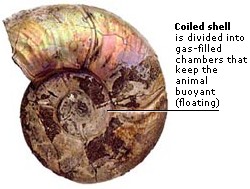DK Nature: Fossils
Fossils are the ancient remains of living things preserved in rocks. They are usually formed from hard animal or plant parts, such as bone, shell, or wood. Studying fossils is a part of PALEONTOLOGY.
When an animal dies, it is rapidly covered by sediment, such as mud or sand. Its soft parts decompose (rot), but its hard parts are gradually replaced by minerals, or fossilized. At the same time, surrounding sediments turn to rock. Millions of years later, the rocks are uncovered, and the organism’s imprint is exposed in its fossil.
Fossils prove that ancient life forms were different from those alive today. They are laid down in layers of rocks, each layer older than the one above. Since evolution is the gradual change in living things over time, fossil layers provide a historical record of the different stages in the evolution of life.
Table 17. FOSSIL RECORD
| 4.5 BYA | Earth forms |
| 3.8 BYA | First living things |
| 500 MYA | First vertebrates (fish) |
| 440 MYA | First land plants |
| 360 MYA | First land vertebrates (amphibians) |
| 248 MYA | First mammals appear |
| 150 MYA | Earliest birds |
| 65 MYA | Dinosaurs extinct |
| 60 MYA | Mammals diversify |
| 2 MYA | Ice ages |
| 160,000 YA | Modern humans appear |
This science studies the evolution, the way of life, and the extinction of organisms that existed in time periods before the present. Paleontologists are scientists who study the fossil remains of species that lived a long time ago.
Fossil evidence shows how features of today’s organisms have evolved over time. Paleontologists can identify organisms that may be ancient relatives of those living today. By looking at fossils from the same layer of rocks, they can also suggest how these organisms lived together in their ancient habitat.
Fossil intermediates are species that provide a link between a new group of organisms and an older group. They also indicate how one group evolved from the other. Archaeopteryx lived 150 million years ago (mya). Its fossils show how birds could have evolved from dinosaurs because its skeleton was like a dinosaur’s, but it had feathers similar to a bird’s.


